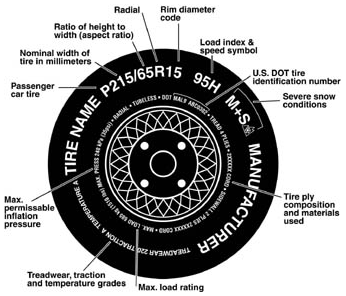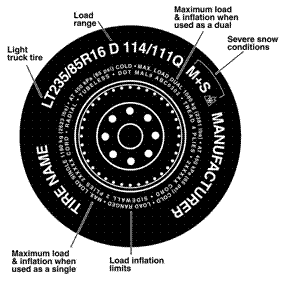Tire code
Automobile tires are described by an alphanumeric code which is generally molded into the side-wall of the tire. This code specifies the dimensions of the tire and some of its key limitations such as load bearing ability and maximum speed.
The code has grown in complexity over the years as is evident from the mix of metric and imperial units and ad-hoc extensions to lettering and numbering schemes. New automotive tires frequently have ratings for traction, treadwear, and temperature resistance (collectively known as The Uniform Tire Quality Grade (UTQG) ratings).
The meaning of tire codes
The tire code consists of a string of letters and numbers, as follows:
- An optional letter (or letters) indicating the intended use or vehicle class for the tire
- 'P' - Passenger
- 'LT' - Light Truck
- 'ST' - Special Trailer
- 'T' - Temporary
- The width of the tire - in millimeters, from sidewall edge to sidewall edge.
- A slash character ('/').
- The ratio of the sidewall height to the total width of the tire - as a percentage. If this is missing, it is assumed to be 82%. If the number is larger than 200, then this is the diameter of the entire tire in millimeters.
- Construction of the fabric of the tire
- 'B' - bias belt
- 'D' - diagonal
- 'R' - radial
- Diameter of the rim that this tire is designed to fit - in inches.
- Load index.
- Speed rating - one or perhaps two letters (see table below).
- Additional marks.
Speed rating codes
The code is made up of one or two letters describing the maximum safe speed for the tire.
| Code | MPH | km/h |
|---|---|---|
| N | 93 | 150 |
| Q | 99 | 160 |
| R | 105 | 170 |
| S | 112 | 180 |
| T | 118 | 190 |
| U | 124 | 200 |
| H | 130 | 210 |
| V | 149 | 240 |
| W | 167 | 270 |
| Y | 186 | 300 |
| ZR | Over 149 | Over 240 |
The code "ZR" means a speed limit for the tire of more than 240 km/h. In this case there is often an additional code, example: 225/45 ZR 17 Y.
Additional marks
There are numerous other markings on a typical tire, these may include:
- M&S: On winter tires, at the end of the above mentioned codes the following abbreviation can be found: M&S for Mud and Snow. On spike tires there is an additional E after the S.
- E4 - Tire approved according ECE-regulations, (the number indicates the country of approval).
- 030908 - Approval number of the tire
- DOT-Number: Production date; DOT = Department of Transportation; example: DOT 3204 = 32nd week in 2004; before 2000 there was a 3 number code with triangle-symbol used, Example: 122◄ = 12th week of 1992; prior this the following code was used: 065 = 6th week of 1985
- TL - Tubeless
- TT - Tubetype, tire with an inner-tube
- Made in - Country of production
- C (commercial) - Tires for light trucks (Example: 185 R14 C)
- B - Bias Belted tires for motorcycles (Example: 150/70 B 17 69 H)=diagonal construction with belt added under the tread
- SFI - abbr. for "side facing inwards" = inside of asymmetrically tires
- SFO - abbr. for "side facing outwards" = outside of asymmetrically tires
- TWI - Tire wear index, an indicator in the main tire profile which shows when the tire is worn down and needs to be replaced
- XL (extra load): Tire for heavy loads
- rf - Reinforced tires
- Arrows - Some tread designs are designed to perform better when driven in a specific direction (clockwise or counter-clockwise). Such tires will have an arrow showing which way the tire should rotate when the vehicle is moving forwards. It is important not to put a 'clockwise' tire on the left hand side of the car or a 'counter-clockwise' tire on the right side.
Tire geometry
When referring to the purely geometrical data, a shortened form of the full notation is used. To take a common example, 195/55R16 would mean that the width of the tire is 195 mm at the widest point, the height of the side-wall of the tire is 55% of the width (107 mm in this example) and that the tire fits 16 inch diameter wheels.
Less commonly used in the USA and Europe (but often in Japan for example) is a notation that indicates the full tire diameter instead of the side-wall height. To take the same example, a 16 inch wheel would have a diameter of 406 mm. Adding twice the tire height (2x107 mm) makes a total 620 mm tire diameter. Hence, a 195/55R16 tire might alternatively be labelled 195/620R16.
Whilst this is theoretically ambiguous, in practice these two notations may easily be distinguished because the height of the side-wall of an automotive tire is typically much less than the width. Hence when the height is expressed a percentage of the width, it is almost always less than 100% (and certainly less than 200%). Conversely, vehicle tire diameters are always larger than 200 mm. Therefore, if the second number is more than 200, then it is almost certain the Japanese notation is being used - if it's less than 200 then the US/European notation is being used.
Example
The tires on a MINI Cooper might be labelled:
P195/55R16 85H
- 'P' these tires are for a passenger vehicle.
- 195 - the width of the tire is 195 mm at the widest point.
- 55 - indicates that the height of the side-wall of the tire is 55% of the width - 107 mm.
- R - this is a radial tire.
- 16 - this tire fits 16 inch diameter wheels.
- 85 - the load index, a maximum of 515 kg per wheel in this case.
- H - the speed index, this means the maximum permitted speed, here 210 km/h (130 mph).
See also
External links

